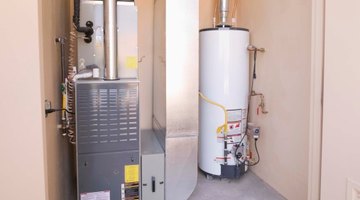How to Change the Filter on a WeatherKing Furnace
WeatherKing is a Rheem-owned brand of heating and cooling systems and components, including central heating furnaces. Like most furnaces and heating systems, WeatherKing systems draw in air, heat it and force it through ductwork with strong fans.

A filter inside the system captures various particles in the air, such as allergy-causing dust and other particles, before the air circulates throughout the ductwork and vents. Regular replacement of the filter is important to maintain clean airflow.
-
Locate the cold air main duct going into the furnace. On WeatherKing furnaces there are two main ducts, a hot air duct and a cold air duct. Determine which duct is the cold air duct by touching the surface of each duct with your hand. The duct that is not warm to the touch is the cold air duct.
-
Inspect the panel area on the front of the furnace nearest the cold air duct. There will be a thin and long metal compartment cover panel on the furnace. Identify this cover panel by the seam running down the front of the furnace near the cold air duct.
-
Pull off the compartment cover panel to reveal the WeatherKing filter. It should come right off if you give it a tug with moderate force.
-
Grasp the exposed side of the filter frame and pull the filter out toward you. Note which side is which so you can be sure to put the new one in the right way.
-
Insert the new filter into the filter compartment, sliding it slowly in place to avoid jamming it and bending its pleats. Verify that the filter is in the exact same direction and orientation as the recently removed filter.
-
Snap the compartment panel piece into place to complete the replacement procedure.
Tip
Replace the filter every few months.
The Drip Cap
- WeatherKing is a Rheem-owned brand of heating and cooling systems and components, including central heating furnaces.
- A filter inside the system captures various particles in the air, such as allergy-causing dust and other particles, before the air circulates throughout the ductwork and vents.
- The duct that is not warm to the touch is the cold air duct.
- Inspect the panel area on the front of the furnace nearest the cold air duct.
References
Writer Bio
Maxwell Payne has been a freelance writer since 2007. His work has appeared in various print and online publications. He holds a Bachelor of Science in integrated science, business and technology.
Photo Credits
- Jupiterimages/Comstock/Getty Images
- Jupiterimages/Comstock/Getty Images
More Articles



